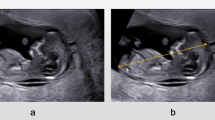Abstract
Purpose
The aims of this study were to describe a new ultrasonographic technique to assess the normal level of the cerebellum and the brainstem in the posterior fossa in normal foetuses and to compare in pathologic cases.
Methods
We propose a new line cross between the dens cervical and the inferior portion of occipitum (occipitum–dens line—ODL). In a cross-sectional study, a single observer with experience in foetal neurosonography evaluated 54 foetuses (40 normal and 14 with open neural tube defect) between 20 and 28 weeks of gestation. The reference points for the ODL are principally the lower portion of the occipital bone (occipitum) and odontoid process of the second cervical vertebra (dens). The line was considered the level zero (near level of foramen magnum). Structures above it had a positive measurement and below it had a negative measurement.
Results
Moreover, in most foetuses with open neural tube defect (93 %), the end portion of cerebellum was below the ODL associated with different degrees of ventriculomegaly.
Conclusion
The proposed innovation aims to bring to the ultrasound the most likely anatomical parameters of evaluation in normal foetuses and in foetuses with spinal dysraphism.



Similar content being viewed by others
References
Chamberlain WE (1939) Basilar impression (platybasia). Yale J Biol Med 11:487–496
McGregor J (1948) The significance of certain measurement of the skull in the diagnosis of basilar impression. Br J Radiol 21:171–181
Mcrae DL (1969) Bony abnormalities at the crania-spinal junction. Clin Neurosurg 16:356–375
Sutton LN, Adzick NS, Bilaniuk LT, Johnson MP, Crombleholme TM, Flake AW (1999) Improvement in hindbrain herniation demonstrated by serial fetal magnetic resonance imaging following fetal surgery for myelomeningocele. JAMA 282:1826–1831
Danzer E, Finkel RS, Rintoul NE, Bebbington MW, Schwartz ES, Zarnow DM, Adzick NS, Johnson MP (2008) Reversal of hindbrain herniation after maternal-fetal surgery for myelomeningocele subsequently impacts on brain stem function. Neuropediatrics 39:359–362
Grant RA, Heuer GG, Carrión GM, Adzick NS, Schwartz ES, Stein SC, Storm PB, Sutton LN (2011) Morphometric analysis of posterior fossa after in utero myelomeningocele repair. J Neurosurg Pediatr 7:362–368
Hutchins GM, Meuli M, Meuli-Simmen C, Jordan MA, Heffez DS, Blakemore KJ (1996) Acquired spinal cord injury in human fetuses with myelomeningocele. Pediatr Pathol Lab Med 16:701–712
Luthy DA, Wardinsky T, Shurtleff DB, Hollenbach KA, Hickok DE, Nyberg DA, Benedetti TJ (1991) Cesarean section before the onset of labor and subsequent motor function in infants with myelomeningocele diagnosed antenatally. N Engl J Med 324:662–666
Adzick NS, Thom EA, Spong CY, Brock JW 3rd, Burrows PK, Johnson MP, Howell LJ, Farrell JA, Dabrowiak ME, Sutton LN, Gupta N, Tulipan NB, D’Alton ME, Farmer DL, Investigators MOMS (2011) A randomized trial of prenatal versus postnatal repair of myelomeningocele. N Engl J Med 364:993–1004
Aboulezz AO, Sartor K, Geyer CA, Gado MH (1985) Position of cerebellar tonsils in the normal population and in patients with Chiari malformation: a quantitative approach with MR imaging. J Comput Assist Tomogr 9:1033–1036
Yamanaka M, Uozumi T, Sakoda K, Kuwabara S, Mikami T, Sumida M, Hasada J, Hatayama T, Kanazawa J, Kajima T, Kagawa Y (1990) Magnetic resonance imaging of Chiari malformations. Neurol Med Chir (Tokyo) 30:246–250
Gammal TE, Mark EK, Brooks BS, Mark EK (1988) MR imaging of Chiari II malformation. AJR Am J Roentgenol 150:163–170
Conflict of interest
The authors declare no conflicts of interest.
Author information
Authors and Affiliations
Corresponding author
Rights and permissions
About this article
Cite this article
de Sá Barreto, E.Q., Moron, A.F., Milani, H.J.F. et al. The occipitum–dens line: the purpose of a new ultrasonographic landmark in the evaluation of the relationship between the foetal posterior fossa structures and foramen magnum. Childs Nerv Syst 31, 729–733 (2015). https://doi.org/10.1007/s00381-015-2621-x
Received:
Accepted:
Published:
Issue Date:
DOI: https://doi.org/10.1007/s00381-015-2621-x




